Everyone knows how amazing it is to sit in front of a crackling fire on those cold Colorado nights. Being safe and cozy with family makes winter an exceptional time of year. But at the end of the night, when it’s time to extinguish the fire, do you know the safest way? Do you know how to put that fire out so that there are no worries of a stray spark or ember popping out and putting your home in jeopardy? There is a right and a wrong way to putting out the fire. Read on to find out some tips on making sure your fire is put to bed before you put yourself to bed.
 Dos and Don’ts
Dos and Don’ts
First of all, don’t throw water on that fire. This will result in a couple of things. First, it could cause a whole lot of smoke, and that’s one thing that all homeowners want to avoid. A smoke-filled room can cause scratchy throats and watery eyes, coughing and lung problems. Another problem created by throwing water on the fire would be ease of clean-up. Wet ashes are harder to clean up than dry ashes, so adding water to your fire will only make clean-up more complicated.
Smother your fire in ashes, then put baking soda over the ashes. This will effectively smother the fire. You may wonder why you should use baking soda. Baking soda, when heated, creates carbon dioxide, and carbon dioxide does a great job of extinguishing fires. This is a much cleaner way to smother your fire.
This is a great way to put out a fire before you turn in for the evening. But sometimes a fire will catch you off guard. This is the case if there’s a chimney fire. Even though we usually think of a chimney fire as a major event, in most cases, it is not. Generally, there’s not enough oxygen in the chimney for a full-fledged roaring fire to take place. Even so, if you do have a chimney fire, there are some things that you should do. First, get your family and pets out of the house as quickly as possible. Then call the fire department. After this, you should close off any openings into your chimney. This will deprive the fire of an oxygen source that could keep the fire burning. You can also put some baking soda or sand onto the fire in the firebox. As a last resort, use your fire extinguisher to put out the fire.
Preventative Measures
If you’re worried about the possibility of a chimney fire, make sure to schedule yearly inspections. One of the big things we’ll be looking for is creosote buildup. Creosote buildup occurs when smoke from your fire rises up and hits the cooler interior of your chimney. Because smoke is made up of the moisture that’s left in the wood you’re burning plus chemicals that are released during the combustion process, when it hits that cool surface, it condenses and forms a layer of gunk and grit called creosote. This is a highly flammable material that, even at as little of an eighth of an inch, can ignite and cause a chimney fire. When we do your chimney inspection and sweeping, we’ll make sure that the creosote is cleared out, thus eliminating this cause of chimney fire.
Keep Your Family Safe
When it comes to fire, you can’t be too careful. Make sure that your fire is out before you turn in for the evening, and know what to do in case of a chimney fire. But remember, the best thing to do is to prevent this from happening in the first place. The expert professionals at Chimney Doctors of Colorado can help you out by making sure that your chimney is clean and clear of obstructions that could cause a chimney fire, but we also have other suggestions on how to keep your family safe from any dangers that burning a fire might produce. We care about the people in the Central Colorado region and will do whatever we can to make sure that our customers are safe and sound all winter long.
